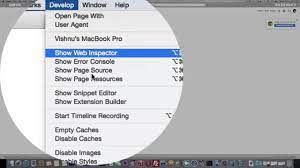
Are you struggling to inspect elements on your Mac? Look no further!
In this article, we’ll show you how to efficiently use the Inspector Tool to navigate the Elements Panel, debug using the Console, and inspect network traffic.
With these advanced techniques, you’ll be able to quickly identify and resolve any issues you encounter.
So grab your Mac and let’s get started!
Setting up the Inspector Tool
To start using the Inspector Tool, you’ll need to first set it up on your Mac.
Setting up the Inspector Tool is a quick and straightforward process. Begin by opening the App Store on your Mac and searching for ‘Inspector Tool.’ Once you find it, click on the ‘Get’ or ‘Install’ button to download and install the tool on your device.
After the installation is complete, you can locate the Inspector Tool in your Applications folder. Simply double-click on the tool to open it.
The Inspector Tool is now ready to use! You can start inspecting various elements on your Mac, such as web pages, applications, and system components, to gain valuable insights and troubleshoot any issues you may encounter.
Navigating the Elements Panel
Navigating the elements panel on a Mac can be done easily using the trackpad or mouse.
To begin, simply open the Safari browser and go to the webpage you want to inspect. Once there, right-click on any element and select ‘Inspect Element’ from the dropdown menu.
The elements panel will then appear on the right side of the screen. You can use the trackpad or mouse to scroll through the panel and explore different elements on the webpage. To expand or collapse specific elements, simply click on the arrow icons next to them.
Additionally, you can hover over an element in the panel to highlight it on the webpage, making it easier to identify and inspect.
With these simple navigation techniques, you’ll be able to effectively explore and analyze the elements of any webpage on your Mac.
Using the Console for Debugging
When debugging, you can use the console to test and troubleshoot code. The console is a powerful tool that allows you to interact with your code in real-time. You can use it to log messages, evaluate expressions, and even modify variables on the fly.
To open the console on a Mac, simply press Command + Option + J in Chrome or Command + Option + C in Safari. Once the console is open, you can start typing your commands. For example, you can use console.log() to print out values and debug your code.
Additionally, you can use console.error() to log error messages and console.clear() to clear the console and start fresh. The console is an essential tool for any developer, so make sure to leverage its power when debugging your code.
Inspecting Network Traffic
Once the console is open, you can use it to view network traffic and analyze requests and responses. This allows you to gain valuable insights into how your applications are communicating with the internet.
By inspecting network traffic, you can identify potential issues, such as slow loading times or errors in data transmission. The console provides a detailed breakdown of each request and response, including headers, status codes, and even the content being transferred.
You can also monitor WebSocket connections and see real-time updates. With this information, you can pinpoint any bottlenecks or errors in your network communication and take appropriate action to optimize performance.
The console is a powerful tool for troubleshooting network-related problems and ensuring the smooth operation of your applications.
Advanced Inspecting Techniques
By utilizing advanced inspecting techniques, you’ll be able to gain deeper insights into your network traffic and identify any potential issues or bottlenecks.
One such technique is deep packet inspection (DPI), which allows you to analyze each packet of data passing through your network. DPI helps you understand the contents of your network traffic, enabling you to detect any malicious activity or performance bottlenecks.
Another technique is flow-based inspection, which focuses on analyzing the flow of data between devices. This method provides a holistic view of your network traffic, helping you pinpoint any abnormalities or congestion points.
Additionally, by using application-layer inspection, you can examine the specific applications and protocols being used in your network. This allows you to identify any vulnerabilities or misconfigurations that may be impacting your network performance.
With these advanced techniques, you can ensure optimal network performance and address any potential issues proactively.
Conclusion
So there you have it, a comprehensive guide on how to inspect on Mac.
With the Inspector Tool, you can easily navigate and debug elements on any webpage.
The Console is a valuable tool for troubleshooting and fixing any issues you may encounter.
And don’t forget to use the Network Traffic feature to analyze the performance of your website.
With these advanced inspecting techniques, you’ll be able to optimize your web development process and create even better websites on your Mac.
Happy inspecting!

